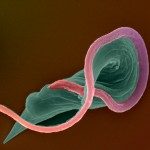Link to Pubmed [PMID] – 27756224
BMC Genomics 2016 Oct;17(1):806
BACKGROUND: African trypanosomes cause lethal diseases in humans and animals and escape host immune attack by switching the expression of Variant Surface Glycoprotein (VSG) genes. The expressed VSGs are located at the ends of telomeric, polycistronic transcription units known as VSG expression sites (VSG-ESs). Each cell has many VSG-ESs but only one is transcribed in bloodstream-form parasites and all of them are inactive upon transmission to the insect vector mid-gut; a subset of monocistronic metacyclic VSG-ESs are then activated in the insect salivary gland. Deep-sequence analyses have been informative but assigning sequences to individual VSG-ESs has been challenging because they each contain closely related expression-site associated genes, or ESAGs, thought to contribute to virulence.
RESULTS: We utilised ART, an in silico short read simulator to demonstrate the feasibility of accurately aligning reads to VSG-ESs. Then, using high-resolution transcriptomes from isogenic bloodstream and insect-stage Lister 427 Trypanosoma brucei, we uncover increased abundance in the insect mid-gut stage of mRNAs from metacyclic VSG-ESs and of mRNAs from the unusual ESAG, ESAG10. Further, we show that the silencing associated with allelic exclusion involves repression focussed at the ends of the VSG-ESs. We also use the approach to report relative fitness costs following ESAG RNAi from a genome-scale screen.
CONCLUSIONS: By assigning sequences to individual VSG-ESs we provide new insights into VSG-ES transcription control, allelic exclusion and impacts on fitness. Thus, deeper insights into the expression and function of regulated multi-gene families are more accessible than previously anticipated.
